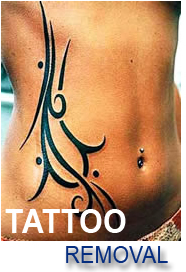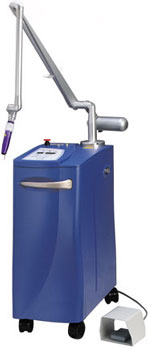|
|


Tattoo Removal
How long are treatments?
Depending on the size of the tattoo, treatments usually range
from 15 to 45 minutes.
How does the Medlite laser work on a tattoo?
The Medlite C6 laser sends precise pulses of high energy light
into the skin, vaporizing some tattoo inks and fragmenting
other tattoo inks into thousands of tiny particles which are
then safely eliminated from your skin.
The high power of the Medlite C6 allows large diameter, deeply
penetrating laser beams to be used, and will help to speed
up the resolution of your unwanted tattoo.
If the area to be treated has a fresh sun tan or has been
treated with self-tanning lotion, it is best to wait a couple
of weeks for the tan to fade before having treatment, because
the tan will absorb and waste some of the laser energy intended
for the pigmented lesion. A fresh sun tan (or color from a
recent application of self-tanning lotion) could also absorb
enough laser energy to increase the risk of skin irritation
or blistering.
 What
will happen after treatment? What
will happen after treatment?
Skin care after laser treatment of tattoos is quite similar
to skin care after having a tattoo. Gentle cleansing of the
skin and application of an antibiotic ointment such as Polysporin
ointment will help tattoos heal quickly after treatment. Watch
for unusual redness, pain, or swelling which might be a sign
of infection, and please call us right away if you think an
infection is developing. Avoid picking or irritating the skin
after treatment.
For the first half-hour after laser treatment the tattoo looks
pale or white, and may swell slightly. The tattoo may feel
hot (like a sunburn) for a while after laser treatment, and
it will probably be red and swollen for the rest of the day.
There may be pinpoint bleeding for a few hours in areas where
there was a lot of pigment.
The area may remain reddened for two to four weeks, and there
may be some flaking or peeling during this time. Sometimes
skin or a scab the same color as the tattoo peels off after
5-7 days. This is a normal process as the body works to eliminate
the tattoo dyes. Very dark, or large professional tattoos,
will remain tender and swollen for a few days.
There may be some lightening or darkening of the skin for
several months after laser treatment. Protect the treated
area from sun exposure until the skin is completely healed
and the skin color has returned to normal.
Your tattoo usually fades over 4-6 weeks. The degree of fading
will be easier to see when you compare your tattoo with pre-treatment
photographs.
How many treatments are required?
When we examine your tattoo, we will be able to give you an
estimate of the number of treatments, which will be necessary
to fade or remove the tattoo. Because there is a great deal
of variability in the kinds, mixtures and quantities of ink
used in tattoos, and because there is some variability in
people's natural ability to clear away tattoo pigment after
laser treatment, it is not possible to "promise"
you that a certain result will happen after a fixed number
of treatments. We will explain what is likely to happen, but
we cannot precisely predict or guarantee what will happen
in any particular case. We will show you photos illustrating
the range of results, from fading through to complete disappearance
of the tattoo.
Some lightly pigmented, black or dark blue, homemade tattoos
like the one above can be removed in one treatment. Amateur
tattoos (which usually have a small amount of superficial
ink) often clear after two to six treatments. A few amateur
tattoos have very deeply placed ink, and this very deep ink
can require more treatments.
New tattoos usually need extra treatments because they have
more ink than old tattoos. Older tattoos have less ink because
as a tattoo ages, the body absorbs some of the ink.
Factors which influence laser tattoo treatment success include
the kind and color of inks used, the ability of the patient's
immune system to clear away pigment after it has been treated,
and location of the tattoo. Multicolored professional tattoos,
especially on the lower legs, tend to respond slowly to laser
treatments, and quite a few multicolored tattoos will need
10 or more treatment sessions for satisfactory fading or complete
removal.
Dark (blue/black) inks and red inks usually fade the best.
Oranges and purples often respond well. Dark inks usually
respond quicker than bright colored inks because dark colors
absorb laser energy better. Light colors such as light green,
yellow and turquoise can be difficult to remove. Sometimes
chemicals like iron oxide or titanium dioxide are added to
tattoo ink to brighten the tattoo - but these chemicals make
it much more difficult to remove the tattoo. Fluorescent "Day
Glow" pigments are almost impossible to remove. Some
tattoos are now made with dark tar-based ink or "laser
resistant ink" and these tattoos (which fortunately are
quite rare) can only be removed by cutting them out.
New tattoos usually need a larger number of treatments because
they have a higher concentration of ink than old ones. Older
tattoos have a lower concentration of ink because as a tattoo
ages, the body absorbs some of the ink.
Tattoos on the face and trunk often respond faster to laser
treatment than tattoos on the ankles.
A professional tattoo like the one shown below (which usually
has more ink, deeper ink, and multiple colors) might fade
considerably after three to six treatments, but it generally
takes between six and ten laser treatments to either completely
remove a professional tattoo or to fade the tattoo so that
it is barely visible (called a "ghost"). Sometimes
complete removal is not possible, or you may find that almost-complete
fading of the tattoo is satisfactory.
How long should I wait
between treatments?
Quick fading or removal can sometimes be accomplished on black
tattoos by using low powered treatments every week or two.
In general, however, it is best to wait at least 6 weeks between
treatments. Sometimes it is possible to fade or remove the
tattoo with a smaller number of treatments if you are willing
to wait 8-12 weeks between treatments, so that your body has
a longer opportunity to clear away pigment after laser treatment.
You should think of the fading and eventual elimination of
your tattoo as a project which you might work on from time
to time over the next year or two.
Will the tattoo completely disappear?
In many cases the tattoo can be made to disappear or fade
to the point where you are the only person who can find a
trace of it, because you know where to look.
Some people choose to over-tattoo (use "cover-art")
to hide an undesirable tattoo. This is especially common when
the original tattoo contains the name of a former lover. If
you have one tattoo on top of an older tattoo, extra laser
treatments will probably be needed because there is likely
to be a large amount of ink (ink from the new cover-up tattoo
plus ink from the old tattoo).
Many tattoo artists encourage customers to have several laser
treatments to lighten an existing tattoo before covering it
with a new one. This will greatly reduce any chance that the
old tattoo will be visible through the new tattoo. We welcome
advice from your tattoo artist about the desired degree of
lightening, and about the exact elements in the old tattoo
which should be lightened or eliminated. You should wait a
month or two after your final laser treatment before having
a new tattoo placed in the treated area.
How much does laser treatment of tattoos
hurt?
Many patients find that the discomfort of their first laser
tattoo treatment is similar to the discomfort they had when
getting the tattoo. There may be less discomfort after the
first couple of treatments because as the tattoo fades there
is less pigment to absorb laser energy.
The impact of the energy from the powerful pulse of light
is similar to the snap of a thin rubber band, or tiny specks
of hot bacon grease on the skin. Most patients do not require
anesthesia, but ice packs, anesthetic creams or local anesthetic
can be used if necessary.
A couple of plain Tylenol can be taken to raise your pain
threshold somewhat before laser treatment.
What are the risks of treatment?
In most cases, the laser treatment leads to satisfactory fading
or complete removal of the tattoo without significant side
effects. Serious side effects are very unusual.
The most common problem with tattoo treatment is incomplete
fading or removal of the tattoo. This is mainly an issue with
complicated multicolored tattoos. Not all tattoo inks respond
and rarely certain colors can get worse. Heavy professional
tattoos in particular may not completely fade. Significant
and sometimes irreversible darkening of tattoo ink may occur,
where the pigment is impossible to remove. This is mostly
a problem with flesh-colored, red, tan, and white inks, and
a small test area can be done to detect this problem.
Although true scarring is very unlikely there can be some
mild change in the texture of the skin (perhaps 1-2% of cases).
Sometimes there is pre-existing texture change in the skin
caused by the tattooing process itself. Please tell us if
you have a tendency toward forming unusual scars.
There can also be some loss of natural tanning ability in
the treated area, which usually improves with time. You can
reduce the chance of irregular tanning by protecting the tattooed
area from sun exposure. Hypopigmentation (lightening of the
skin) or hyperpigmentation (darkening of the skin) are quite
infrequent, and are almost always temporary. The Medlite C6
laser is the safest in the world for dark skin colors. African,
Asian and Mediterranean people can have their tattoos safely
treated without changing the surrounding skin color.
Allergic reactions can occur after treatment, especially if
you are already having an allergic reaction (redness and itching)
in your tattoo. Allergic reactions are rare, and can usually
be treated with Benadryl™. Allergic reactions are usually
caused by metallic dyes, which contain mercury, manganese,
chromium, cobalt, or cadmium. In contrast to drugs and cosmetics,
tattoo pigments have never been controlled or regulated in
any way, and the exact composition of a given tattoo pigment
is often kept a "trade secret" by the manufacturer.
In most cases, neither the tattoo artist nor the tattooed
patient has adequate information about the composition of
the tattoo pigment.
You should be mentally and emotionally stable when having
any cosmetic procedure. This will help you to deal with the
healing period after each treatment, and give you the patience
and persistence to get through the complete series of treatments,
which will be spread over many months.
After any kind of surgery or cosmetic treatment some patients
experience a lull or down period where they become depressed
or feel unattractive while healing. This is normal, but fortunately
these feelings are quite uncommon and usually resolve after
a few days or weeks. It is important to be patient and remain
positive as this promotes better healing and relaxation. It
is best not to pass judgment on your progress until the healing
process has completed.
|

